Gears are machine elements that transmit motion by means of
successively engaging teeth. The gear teeth act like small
levers.
Gears may be classified according to the relative position of the axes of
revolution. The axes may be
- parallel,
- intersecting,
- neither parallel nor intersecting.
Here is a brief list of the common forms. We will discuss each in more detail
later.
-
Gears for connecting parallel shafts
-
Gears for connecting intersecting shafts
-
Neither parallel nor intersecting shafts
Gears for connecting parallel shafts
- Spur gears
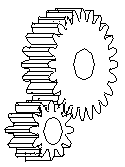
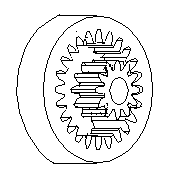
The left pair of gears makes external contact, and the right pair
of gears makes internal contact
- Parallel helical gears
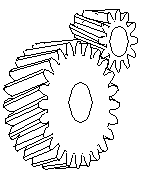
- Herringbone gears (or double-helical gears)
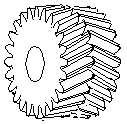
- Rack and pinion (The rack is like a gear whose axis is at
infinity.)
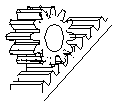
Gears for connecting intersecting shafts
- Straight bevel gears

- Spiral bevel gears
Neither parallel nor intersecting shafts
- Crossed-helical gears

- Hypoid gears
- Worm and wormgear
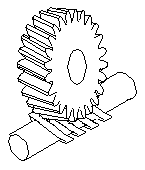
Figure 7-2 shows two mating gear teeth, in which
- Tooth profile 1 drives tooth profile 2 by acting at the instantaneous
contact point K.
- N1N2 is the common normal of the two
profiles.
- N1 is the foot of the perpendicular from O1
to N1N2
- N2 is the foot of the perpendicular from O2
to N1N2.

Figure 7-2 Two gearing tooth profiles
Although the two profiles have different velocities V1
and V2 at point K, their velocities along N1N2
are equal in both magnitude and direction. Otherwise the two tooth profiles
would separate from each other. Therefore, we have
 (7-1)
(7-1)
or
 (7-2)
(7-2)
We notice that the intersection of the tangency N1N2
and the line of center O1O2 is point P, and
 (7-3)
(7-3)
Thus, the relationship between the angular velocities of the driving gear to
the driven gear, or velocity ratio, of a pair of mating teeth is
 (7-4)
(7-4)
Point P is very important to the velocity ratio, and it is called the
pitch point. Pitch point divides the line between the line of centers and
its position decides the velocity ratio of the two teeth. The above expression
is the fundamental law of gear-tooth action.
For a constant velocity ratio, the position of P should remain
unchanged. In this case, the motion transmission between two gears is equivalent
to the motion transmission between two imagined slipless cylinders with radius
R1 and R2 or diameter D1
and D2. We can get two circles whose centers are at O1
and O2, and through pitch point P. These two circle are
termed pitch circles. The velocity ratio is equal to the inverse ratio of
the diameters of pitch circles. This is the fundamental law of gear-tooth
action.
The fundamental law of gear-tooth action may now also be stated as
follow (for gears with fixed center distance)
(Ham 58):
The common normal to the tooth profiles at the point of contact must always
pass through a fixed point (the pitch point) on the line of centers (to get
a constant velocity ration).
To obtain the expected velocity ratio of two tooth profiles, the
normal line of their profiles must pass through the corresponding
pitch point, which is decided by the velocity ratio. The two profiles
which satisfy this requirement are called conjugate profiles. Sometimes,
we simply termed the tooth profiles which satisfy the fundamental law of
gear-tooth action the conjugate profiles.
Although many tooth shapes are possible for which a mating tooth could be
designed to satisfy the fundamental law, only two are in general use: the
cycloidal and involute profiles. The involute has important
advantages -- it is easy to manufacture and the center distance between a pair
of involute gears can be varied without changing the
velocity ratio. Thus close tolerances between shaft locations are not
required when using the involute profile. The most commonly used conjugate
tooth curve is the involute curve
(Erdman & Sandor 84).
The following examples are involute spur gears. We use the word involute
because the contour of gear teeth curves inward. Gears have many terminologies,
parameters and principles. One of the important concepts is the velocity
ratio, which is the ratio of the rotary velocity of the driver gear to that
of the driven gears.
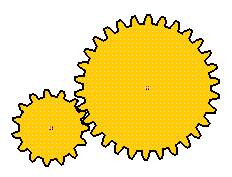
The SimDesign file for these gears is simdesign/gear15.30.sim. The
number of teeth in these gears are 15 and 30, respectively. If the 15-tooth gear
is the driving gear and the 30-teeth gear is the driven gear, their velocity
ratio is 2.
Other examples of gears are in simdesign/gear10.30.sim and
simdesign/gear20.30.sim
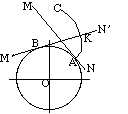
Figure 7-3 Involute curve
The curve most commonly used for gear-tooth profiles is the involute of a
circle. This involute curve is the path traced by a point on a line as
the line rolls without slipping on the circumference of a circle. It may also be
defined as a path traced by the end of a string which is originally wrapped on a
circle when the string is unwrapped from the circle. The circle from which the
involute is derived is called the base circle.
In
Figure 7-3, let line MN roll in the counterclockwise direction on the
circumference of a circle without slipping. When the line has reached the
position M'N', its original point of tangent A has reached the
position K, having traced the involute curve AK during the motion.
As the motion continues, the point A will trace the involute curve AKC.
- The distance BK is equal to the arc AB, because link MN
rolls without slipping on the circle.
- For any instant, the instantaneous center of the motion of the
line is its point of tangent with the circle.
Note: We have not defined the term instantaneous center previously.
The instantaneous center or instant center is defined in two
ways
(Bradford & Guillet 43):
- When two bodies have planar relative motion, the instant center is a
point on one body about which the other rotates at the instant
considered.
- When two bodies have planar relative motion, the instant center is
the point at which the bodies are relatively at rest at the instant
considered.
- The normal at any point of an involute is tangent to the base circle.
Because of the property (2) of the involute curve, the motion of the point
that is tracing the involute is perpendicular to the line at any instant,
and hence the curve traced will also be perpendicular to the line at any
instant.
- There is no involute curve within the base circle.
Figure 7-4 shows some of the terms for gears.
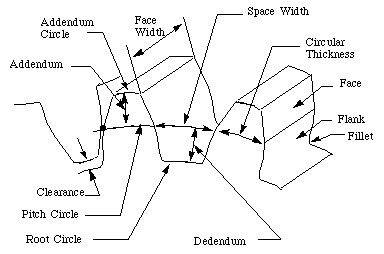
Figure 7-4 Spur Gear
In the following section, we define many of the terms used in the analysis of
spur gears. Some of the terminology has been defined previously but we include
them here for completeness. (See
(Ham 58) for more details.)
|

